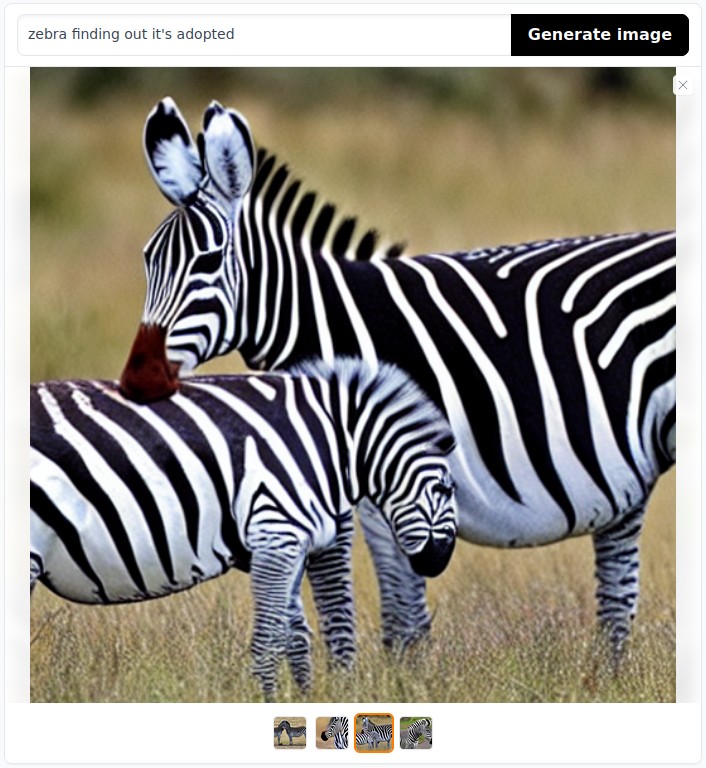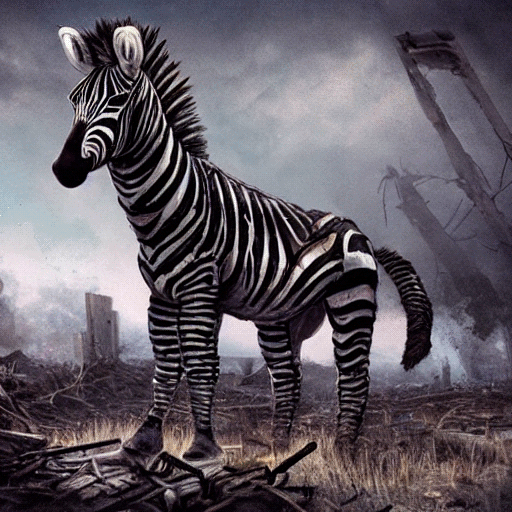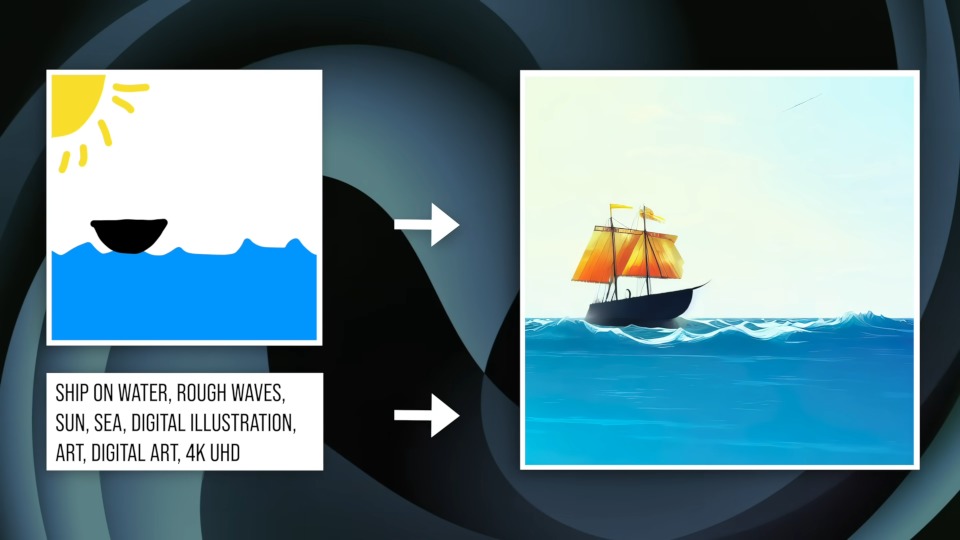Zippy Zombie Zebras features 20 backgrounds generated by Stable Diffusion (at stablediffusionweb.com, hence the 512×512 resolution – I don’t have a capable graphics card to run it locally and would rather not pay for a service). The non-zebra ones are real photographs.

While I intentionally picked images that are cursed and unrealistic, I’d like to discuss the ethical side of generating images this way, as it has only recently become possible to generate semi-convincing images – particularly in the style of paintings, where, in my opinion, it’s less obvious something’s wrong compared with images that look like photographs.
Copyright
I must admit, this is at the forefront of my mind. If you draw something, you automatically own the copyright to that drawing. If you hire someone to draw something for you, you might own the copyright or the artist might own the copyright – it depends what’s decided between you.
But if artificial intelligence draws something? Well, the software can’t own the copyright… so do you own the copyright? This is an ambiguity we’re still working out. As such, I’m placing no licence on the AI-generated images contained within this game and article. If you want to use them, I won’t chase you up on it, but I won’t defend your use of them either.
Muddying the waters further is the fact these programs are trained on datasets of public images, many of which are under copyright. It’s not terribly uncommon to see watermarks in AI-generated images, and sometimes multiple images clearly stem from the same base.

In fact, at the time of writing, Getty Images has banned the upload of AI-generated images. Gee, I wonder why.

Now, if I take an image from a stock photo website, I have clearly stolen it. Even if I crop it and flip it and all sorts to try and avoid being caught, I am using an image I don’t have the rights to in that hypothetical situation and could face legal ramifications.
But if a bunch of stock photos are mashed together into an AI abomination… what then? If this is a breach of copyright, how do you prove what work was stolen? I’ve tried running a few of my AI-generated images through Google Image’s reverse search feature, and never had any hits.
Taking artists’ jobs
As with any advancement in technology, the age-old issue of the potential for job loss looms. And, while I see potential for new jobs as a result (people who know the best prompts and settings), I don’t think there’s any reality in which the new jobs would outweigh the ones lost.
In my case, it doesn’t really make any difference. I would not have hired someone to draw cursed zebras for this game (art is expensive!) nor would I have used licenced stock photos.
But it certainly can make a difference in the grand scheme of things. The imperfections of AI-generated images are less prominent when shrunk down to the size of a profile picture, so I could see people who commission art for profile pictures to just use an AI image generator instead.
In the professional world, it could make a serious splash, as, let’s face it, this is where the money is. A good point was raised by Oliver Mackenzie in the this Digital Foundry video, focused on image generation for the purpose of game development, which is: not only can it be used for generating concept art (as at that stage in development it doesn’t really matter if the results are a little messy), but it can also be used for transforming concept art into something a little more refined.

Inappropriate images
Sometimes, the web whatsit wouldn’t show me some of the images, as it declared them unsafe. I have a morbid curiosity for what it blocked. They could be genuinely “unsafe” images, or the system could have struck a false positive.
Obviously some prompts will lead to more “unsafe” things than others. It doesn’t appear to block any particular words from being input. Some words get ignored, but I believe this is due to it not understanding rather than it refusing to work with them.
So… will we see AI-generated adult material? I think it’s an inevitability. I don’t know if that’s a bad thing – it can’t be any more degenerate than the drawings out there today.
Fortunately, I didn’t encounter anything scarring during my travels. Even quite grizzly prompts about beheadings and whatnot generally just resulted in quite normal-looking zebras. The most disturbing result I got was this Pennywise one.
AI scams
An older example of AI images is This Person Does Not Exist, dating back to December 2019. While some of them do look a bit iffy, it truly is remarkable. Aaand guess what that website is used for. Yep, fake social media profiles – stuff like that. If you want to have a company that looks real, you can generate your staff. Despicable, really.
Text generators such as GPT-3 are also problematic. If you’ve ever come across pages on the internet in recent years that are written a bit oddly, and not so much in the sense of appearing to be written by someone who doesn’t speak the language very well, it was probably written by a computer. This is pretty bad in itself, taking clicks away from articles written by real people, but could we see this go further? Books written by AI, etc.
How about we go to 2018 and have AI sounding like a real person on the telephone? As much as I’d like cold callers to be out of a job, that would be fighting fire with fire.
Some other notes
This could simply be down to the content and small quantity of my images, but I’ve found them to be larger in file size than real photographs when saved as PNGs. Possibly something about the generation process results in image data that is more complex to lossless compress. Or it could just be that my photographs were once JPEGs, so some data has already been removed, and this tossed data still has an effect even after resizing the image to a much smaller size.
I’m not especially interested in why they are the size they are, so I haven’t experimented with it. If you want to think like the printer people, you could believe there’s additional data encoded into the pixels – at least when using the online version. If someone generated something really horrible, I could imagine the Stable Diffusion people wanting to piece together enough data to reproduce the horribleness and prevent it from happening again.
In any case, I’m going to keep JPEGing them, for the sole purpose of reducing their file sizes.
Will I continue using AI imagery?
Maybe? Not sure. I don’t have a great deal of use for it at the minute. For example, I can’t tell it to generate a character’s walk cycle with a transparent background. But one day, maybe.
The most promising aspect I find in it at present for my own use is the potential to generate background images. Things like landscapes, especially when they’re not the focus of your attention, are less likely to strike any uncanny valley vibes than pictures of people, for instance.
Comment on this article at itch.io
2025-11-11 update regarding Getty Images watermarks
Apparently there was a lawsuit. They lost. That’s interesting, but three years have passed since I wrote about this. In all honesty, it no longer seems relevant. I don’t know about Stable Diffusion specifically, but image generators as a whole appear to have improved at not reproducing watermarks and other undesirable things.
